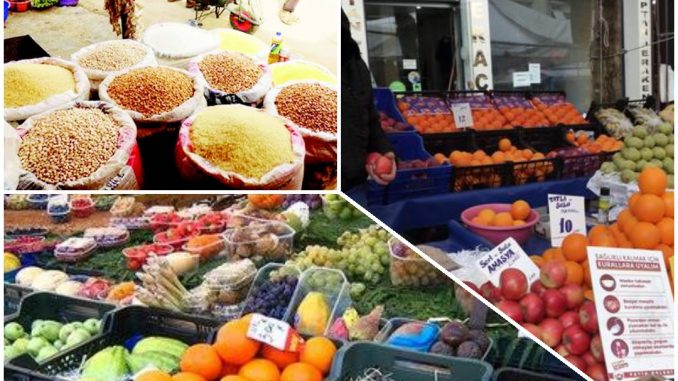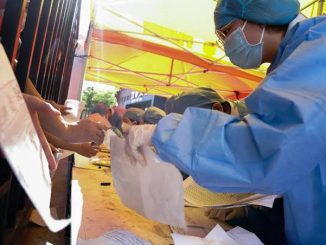
By Kehinde Adeoye
Ever since after the unfortunate outbreak of the Covid-19 pandemic, that was first reported from Wuhan, China, on 31 December 2019, the world economy has been thrown into disarray. World powers including the United States went neck deep into recession. It was same story for other American and European countries. The global health crisis also took its toll on the African continent and Nigerian wasn’t left behind.
All over the world, deaths were recorded and several homes were affected by loss of jobs, shelter and livelihood. Lockdown were subsequently initiated in every part of the world to limit the spread of the virus which perhaps was grossly felt in some places than others. But even at that, thus far, the coronavirus-related deaths worldwide has passed a grim milestone of 4 million.
After the introduction of lockdown which made it difficult for people to go about their businesses. It got worse for artisans and business owners who made their living through daily sales unlike salary earners. Governments throughout the world encouraged citizens to stock up food items for the lockdown. At that time, it was uncertain when movements would resume. Most people had to withdraw their savings to feed their families.
Nigeria’s economy was shut down at the twilight of March 2020, as a result of this problem which halted all production activities, movements and major economic activities. Some small and medium scale business owners with huge employees had to lay off their workers, downsize or close down the entire business because they couldn’t meet up with the monthly financial obligations towards their workers.
The agricultural sector was one of the several sectors affected by the pandemic globally, because the lockdown was put in place during the planting season. Despite the fact that it was subsequently relaxed a little to enable farmers to cultivate, they had difficulties accessing farm inputs and transporting the same across the markets.
Narrowing it down to Nigeria now, we would recall that prior to the outbreak of the coronavirus pandemic, clashes between farmers and herdsmen were rampant. That prompted heavy reduction in production of food crops especially in the northeastern parts of Nigeria. Most farmers who have had terrible experiences with the clashes either stopped farming or reduced the capacity of farm production.
The COVID-19 lockdown restricted the transportation of goods, especially food items, across the country. A ban on inter-state movement and farmers’ inability to cultivate their farmlands, amongst other processes, posed a challenge on food security in the country. So, it wasn’t unexpected that these unusual distortions of farming activities and agricultural business would shrink the supply of various farm produce, with attendant increase in prices of food items.
A market survey by Dataphyte, a media research and data analytics organisation indicates that “Nigerians witnessed an average of 66.8% increase in the prices of food items between last year (2020) February, the month the first case of coronavirus was confirmed, and at March (2020), when the survey was conducted.
Dataphyte’s analysis of the prices of foodstuffs across 13 states in the country, one of the most extensive market surveys in the country showed that the food price situation had contracted the purchasing power of citizens. The states sampled were Anambra, Benue, Enugu, Ebonyi, Abuja (the Federal Capital Territory, FCT), Kano, Kwara, Lagos, Niger, Ogun, Ondo, Oyo, and Sokoto states.
“The price of beans and garri nearly doubled within the period under review. Beans rose from N1,457 to N2,883 per paint rubber, representing an estimated 98% (97.92%) increase. The cost of garri rose from N869 to N1,856 per paint rubber, an estimated 97% (97.27%) change. The price increases of these two staple foods were the highest in the last one year period of the coronavirus pandemic,” Dataphyte said.
Garri is made from cassava, a tuber plant, which is one of the most important food crops in West Africa. Nigeria produces about 250,000 tonnes of it annually. Nigeria is also regarded as the largest producer of cassava in the world. Garri is either made into ‘eba’ or soaked to drink as flakes. It is often regarded as the ‘poor man’s food,’ in Nigeria, because of its relatively low price and the ease of taking it as a snack without need of cooking, unlike most of the other food items.
Dataphyte further disclosed in its report here.
However, sustained violence and a general state of insecurity in the country, especially in the northeast of the country, could have contributed to the scarcity of the farm products and processed food items.
But statista making a disclosure from its survey on the percentage change in prices of selected food products in Nigeria 2021 said: “In May 2021, food prices in Nigeria increased considerably compared to May 2020. Maize, gari (or garri), oil, and beans prices increased the most. In particular, the price of white gari grew by over 50 percent compared to the previous year, while the price of yellow maize grain added up to 51 percent more. Among all selected food products, no item recorded a decrease in price. In fact, Nigeria is among the countries with the highest inflation rate in the world and recorded a fast growing CPI.”
Other factors responsible for the food price surges include border closure, said to have contributed 4%. General Insecurity, terrorism, killings, kidnapping, farmers-herder clashes were also said to have directly contributed about 3% of the cause.
Now, in a bid to reduce hunger and scarcity as well as cater for the welfare of Nigerians, especially the poor households, the Federal Government through the Ministry of Humanitarian Affairs gave out tokens and distributed palliatives throughout the states.
ALSO READ: N75bn ESP: Survival fund beneficiaries will be evenly distributed across states —Presidency
Since the intervention of the Federal Government (FG) to share palliatives and cash to the poorest of the poor had little effects, the FG saw the need to further address the state of the nation with the introduction of the Economic Sustainability Committee chaired by Vice President Osinbajo. This was created specifically to address the post Covid-19 issues affecting the economy.
Nigeria Economic Sustainability Plan (ESP) was approved by the Federal Executive Council on June 24, 2020, as established by President Muhammadu Buhari on March 30, 2020. Chaired by Vice President Yemi Osinbajo, the ESC comprised several Cabinet Ministers as well as the Group Managing Director of the NNPC and the Governor of the Central Bank of Nigeria.
While inaugurating the committee on the April 2, 2020, the Vice President noted that “what Mr President has asked us to do is to devise a strategy in order to be able to keep the economy going and also make provisions to ensure that we are able to retain jobs and indeed create more.”
“We also need to develop the Nigerian economy in a way that we will even take advantage of the challenges of these times and convert those challenges to opportunities,” Prof Osinbajo said.
Speaking further on the responsibilities of the committee, the Vice President said “what we will need to do is something that is bold, radical and one that our people can understand and buy into.
“We must design a broad vision that takes into account how to implement a big plan inclusive of a focus on mass local productivity and mass employment.
“The big plan of government is to find a way for us to be able to do mass housing, increase agricultural production, ensure massive local productivity by among several other options, increasing support to MSMEs, and majorly improve avenues to put more cash in the hands of our people and also make them productive,” the VP noted.
After deliberations by the committee, the Vice President submitted its report for implementation on the 11th of june, 2020 with the theme “Bouncing Back”. The President reacting to the development appreciated the committee while tagging the plan a “National Plan.
“I’m pleased to hear that the Economic Sustainability Committee consulted with all the National Economic Councils and the National Assembly, and I look forward to our continued partnership with one focus to implement what I consider a national plan,” the President noted.
The Vice President said the Committee was motivated by President Buhari’s directive to come up with a plan that would to provide succour to Nigerians, taking into account the dangers posed to the economy by the global economic slowdown, which also resulted in a drastic fall in crude oil production and prices, with serious implications for government revenues and foreign exchange earnings.
ALSO READ: Osinbajo impressed with progress of MSMEs, says FG will resolve their challenges, remove bottlenecks
Speaking after receiving the ESC plan from the VP, President Buhari said the committee was established because “during these uncertain times, the government saw the need to act quickly and avert the worst; while government continues to seek ways of supporting businesses and industry. The President added that the administration is determined “to support business especially sectors facing difficulty as the effect of the Covid-19 pandemic and the resultant socio-economic Covid-19,” while it focuses on implementing the recommendations of the national plan.
The President stated that the recommendations in the plan would help in developing a truly competitive economy that can support our people and secure our future. He said “I congratulate the Economic Sustainability Committee for completing this critical national assignment in good time,” he added. He also commended Nigerians for their resilience in adapting to the Covid-19 pandemic, as well as the efforts of health workers whom he said, “continue to play critical role in keeping our country safe.”
Prof. Osinbajo, still on the same issue added, “In other words, to create millions of new jobs, we need to focus on encouraging local production, local services, local innovation, and emphasize the use of local materials. Nigeria and Nigerians can produce our food, build our houses and construct our roads, using local materials in all cases. If we must import, it must be to support local production. We have, therefore, recommended that we must carry out mass programmes that create jobs and utilise local materials.”
A mass agricultural programme, mass housing programme, support for micro, small and medium enterprises, reduction in NAFDAC registration fees, survival fund, strengthening the social safety net are the proposed key projects among others were created to alleviate the problems.
ALSO READ: COVID 19: How FG’s Social Intervention Programme’s beneficiaries were selected — Presidency
Also, informing further on developments, to Laolu Akande, the Senior Special Assistant to the Vice President on media and publicity, in a State House press release on the July 5, 2021, breaking down the workings/implementation of the ESP so far, indicated that “the target of N2.3 trillion estimated to be spent under the plan has not been achieved just as yet, the Federal Government appropriation part of that total being N500 billion has been completely released by the end of May (2021), making it possible to attain several objectives of the ESP directly supporting a few million Nigerians.”
“While a total of 2,100,021 jobs have been saved and created all together, the breakdown of the figures indicate that 1.3 million jobs have been retained through interventions in the Micro, Small and Medium Enterprises (MSMEs) space, including the Payroll Support. The 774,000 jobs from the Public Works Programme and 26,021 Jobs from construction /rehabilitation projects across the country were among those freshly created.”
“In the agricultural sector, over 6 million farmers have been enumerated, 3.6 million passed the first stage of validation and 2.4 million scaled the second validation stage. The Minister added that 129,000 crop farmers and 38, 333 animal farmers have been profiled for the Interest Free Loan Support for the dry season farming cycle.”
ALSO READ: Coronavirus variants threaten global recovery, G20 warns
He added that “under the COVID-19 intervention programme for the health sector, the establishment of 520 Intensive Care Units (ICU) Beds, 52 Molecular Laboratories and Isolation Centres at Federal Tertiary Hospitals is at 67% completion.”
N500 billion representing 100% of the total sum in the budget has been released to all the programmes of the ESP as at May 30, 2021.
“The Social Intervention Programme and Support to Persons of Concern received N34.957 billion; WASH Programme and Energy Support to Vulnerable Communities received N22.315 billion; support for building a resilient health system received N116 billion; support for the operations of Security Forces was put at N15.674 billion, and the 36 States of the Federation received N50 billion,” Akande disclosed in the statement.
Likewise, updating the meeting on the implementation of the Agriculture for Food and Job Plan, the Technical Assistant to the Minister of Agriculture and Rural Development, Dr Andrew Kwasari, said the construction of 340 km of rural roads across the federation under Federal Ministry of Agriculture and Rural Development (FMARD) have been completed to aid the movement of goods and services.
He added that “the clearing of 3,200 hectares of land in 8 States have been completed, while the President has granted approval for fertilizer subsidy to over 1 million farmers already enumerated under the Agriculture for Food and Job Programme.”
On his part, the Managing Director of Rural Electrification Agency (REA), Ahmad Salihijo Ahmad said “the Solar Power Naija Programme under the ESP was progressing steadily with more communities to be connected under the Niger Delta Power Holding Company (NDPHC) 100,000 solar connections, among other components of the programme.” All these are to cushion the effects of the economic hardship in the country.
He added that the agency under the Energy for All initiative has completed the connection of 200 Primary Healthcare Centres and 104 schools across the country to solar power with plans to connect more schools and health centres.
Under the Social Housing Scheme, the Managing Director of the Family Homes Fund, Mr Femi Adewole, said “the scheme is progressing steadily as the financing agreement between the Family Homes Fund and the CBN has been finalized while the Ministry of Finance has provided the necessary guarantee for the project.”
He added that “the disbursement request for N30 billion to finance a total of 29,600 homes will be submitted to the CBN for processing before the end of this week.”
With the above breakdown, it is evident that the plan is robust and it’s a fair way out of our current economic mess. We would recall that the ESP is said to have been one of the economic components that recently lifted us out of recession.
With these plans under the ESP still ongoing, Nigerians should be optimistic that it’s effect will be felt largely on the citizenry and the tension built by the scarcity and hike of food items will soon be a thing of the past.
However, looking at it further on the global scale, for instance, for Cleanne Brito Machado, like millions of people in developing countries around the world, shopping for staple foods such as rice, beans, oil or potatoes now means making hard choices.
“The shopping cart is getting much smaller and we’re paying much more,” said the 41-year old, who works as a maid in Brazil’s capital Brasilia. “We’ve had to give up on little trips, visiting family at the weekend, and we haven’t been able to save any money for emergencies or to have in the bank.”
A mix of currency depreciation, rising commodity prices and coronavirus disruptions saw food inflation soar 14% last year in Latin America’s largest economy – the biggest increase in nearly two decades. The headline figure masks hikes in staples, such as a 76% jump in rice or a doubling of soy oil prices.
Other developing countries from Turkey to Nigeria also recorded double-digit jumps in food inflation. Major wheat and corn exporters such as Russia or Argentina have introduced curbs or taxes to preserve domestic stockpiles, exacerbating pressures elsewhere.
United Nations data showed food prices hit six-year highs in January after rising for eight consecutive months.
The unwelcome return of food price pressures has put policymakers and investors on high alert, worried what it means for inflation more broadly while economies are still reeling from the coronavirus crisis.
“Central banks will be watching the level of food prices quite carefully over the next few months because they will have to make a decision on whether to respond to this or not,” said Manik Narain, head of emerging market strategy at UBS.
Graphic: EM food inflation and FAO here
Food is the single largest element of inflation baskets in many emerging markets, accounting for around half in countries like India or Pakistan compared to less than 10% in the United States.
Rising food prices have contributed to social unrest in the past. Climate change effects are expected to exacerbate price swings and rising energy prices add to the pressure.
For those like Machado, higher food bills leaves less to spend on other goods, squeezing demand for items from travel to eating out.
Many countries have already seen hard currency revenues from sectors such as tourism crater and they lack the capacity of their richer peers to pump in stimulus.
For central banks, the temptation may be to let inflation rise and keep monetary conditions loose to support growth, say analysts.
“It is a very difficult balance – governments in emerging markets are damned if they do and damned if they don’t,” said David Rees, senior emerging markets economist at Schroders.
“As a policymaker – do you choose to support your population or choose keeping the markets happy?”
Developed economies generally see food inflation as transitory. But in developing nations, persistent food price rises in the run up to the 2008 financial crisis lifted core inflation, prompting years of interest rate hikes.
Cautionary Tale
In Istanbul, food market vendor Seref Geyik says he has seen the effect of opening hours cut short by the pandemic and rising wholesale prices of fruit and vegetables.
“Consumers are leaning towards cheaper stalls, they are not looking for good quality produce,” the 53-year old said.
Relying heavily on imported unprocessed foods, Turkey saw food price rises accelerate from August, when the lira chalked up monthly losses of 5% or more against the dollar.
With nearly all its energy also imported, rising energy prices from early November have added to the pressure. Dry weather has meanwhile hampered production of some local crops, from hazelnuts and chestnuts to apricots and olives.
Graphic: Inflation in emerging markets here
Turkey’s experience of chronically high inflation two decades ago is a cautionary tale of how price pressures can derail economic growth and shatter household and investor confidence.
New central bank governor Naci Agbal has launched a dedicated department to monitor food and agricultural prices to serve as an “early warning” system.
In January, Brazil’s central bank abandoned forward guidance that rates would stay low after the real came under pressure and bond markets sold off. In a nod to changing priorities, deputy governor Fernanda Nechio said keeping inflation under control has helped lift large numbers of people out of poverty.
Analysts predict Russia and South Africa will make the same journey, Reuters said in an analysis.
Keeping interest rates unchanged in December, Russia’s central bank governor Elvira Nabiullina pointed to secondary effects from a rise in global food prices and the weaker rouble.
Few expect pressures to ease soon, with Chinese demand which sent global cereal prices to a six-year high showing little sign of abating.
Rice price increases led to unrest in several countries during the 2008 food crisis, and food inflation was a contributor to the Arab Spring revolts a decade ago.
“We have seen in the past instances of protests apparently at least triggered by food price spikes, (especially) when prices of staples are increasing,” said Moody’s managing director Marie Diron.
The general submissions have attested to the fact that the hike in food prices is not peculiar to particular countries, even, as the Food and Agriculture Organization of the United Nations (FAO) noted that the global food prices rose in that 2020 at their fastest monthly rate in more than a decade, informing that the world cereal production is on course to reach a new record high.
Also, checking figures from last year, as the FAO Food Price Index averaged 127.1 points in May, 4.8% higher than in April and 39.7% higher than in May 2020, and still, there hasn’t been much improvements in July 2021, more than a year after, carefully looking at the situation, experts have blamed the hike in food prices more on the inevitable natural occurrences than on human factors. Hence, with these disclosures, one can only be hopeful that things get better soonest.




